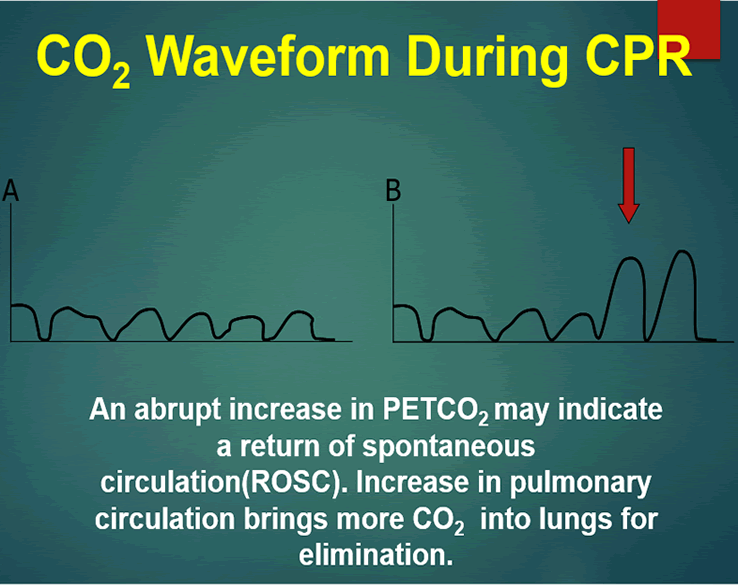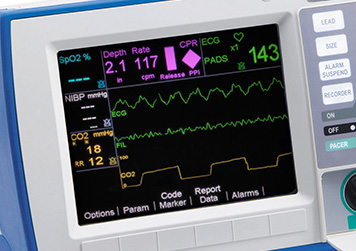end tidal co2 monitoring cpr
Also called capnometry or capnography this noninvasive technique provides a breath-by-breath analysis and a continuous recording of ventilatory status. Based on an extensive review of available.

Use Capnography For A Patient In Cardiac Arrest Capnoacademy Capnoacademy
End tidal CO 2 monitoring is represented as a number and a graph on a monitor.

. Prehosp Emerg Care. Two very practical uses of waveform capnography in CPR are. 1 evaluating the effectiveness of chest compressions and 2 identification of ROSC.
Murphy RA Bobrow BJ Spaite DW et al. End-tidal carbon dioxide ETCO 2 monitoring is readily available easily used and a standard of care in the operating suite and in the critical care setting. This is exactly what were using end-tidal CO2 for in ACLS.
Here are five things you should know about waveform capnography in cardiac arrest. This will cause a decrease in the ETCO2 end-tidal CO2 and this will be observable on the waveform as well as with the numerical measurement. End tidal co2 monitoring nursing considerations Saturday March 12 2022 Edit.
We monitored end-tidal CO2 values continuously during cardiac resuscitation in 23 humans while ventilation was held constant with a computer-controlled CPR Thumper. End-tidal carbon dioxide PetCO moni- toring is becoming more common in both the ED and the out-of-hospital setting. Loss of ETCO2 may be the first sign that CPR is needed.
Wayne MA Miller CC. We investigated whether ETCO2 is more or less accurate than cerebral oxygen saturations as a monitor of. Gradual fall in ETCO2 suggests compressionist fatigue during CPR - time to change compressionists.
Ad View a brochure to learn about end-tidal CO2 capnography. In fact its commonly called the ventilation vital sign. End-tidal CO2 ETCO2 detection requires air movement.
End-tidal carbon dioxide ETco 2 monitoring provides valuable information about CO 2 production and clearance ventilation. Capnograph is an indispensable tool for monitoring metabolic and respiratory function. Although the normal range for CO2 should be between 35-45mmHg CO2 monitoring gives healthcare providers a lot more insight into what is going on with a patients condition.
When a capnometer is available and the machine is warmed-up connection to the ventilatory circuit takes CPR whether ventilating via bag-mask. Waveform capnography should be monitored in all intubated patients and displayed on the monitor as above. End-tidal CO2 EtCO2 monitoring is a noninvasive technique which measures the partial pressure or maximal concentration of carbon dioxide CO2 at the end of an exhaled breath which is expressed as a percentage of CO2 or mmHg.
Between end-tidal carbon dioxide and CPR quality during both in-hospital and out-of-hospital cardiac arrest. Lewis LM Stothert J Standeven J Chandel B Kurtz M For對tney J. Although the normal range for CO2 should be between 35-45mmHg CO2 monitoring gives healthcare providers a lot more insight into what is going on with a patients condition.
Another method of monitoring the quality of the circulation and blood flow during cardiopulmonary resuscitation CPR is to measure the amount of carbon dioxide present in a patients exhalations called end-tidal carbon dioxide or ETCO2. Multiple monitoring options so you can choose what and how to monitor respiratory status. Remember the cells are going to use this oxygen create the CO2 but I still have to have adequate cardiac output a working pump to pump that CO2 all the way back to the lungs so it can be exhaled and measured.
EtCO2 is a measurement of the partial pressure of CO2 in gas expired at the end of exhalation when exhaled gas will most closely resemble the alveolar CO2 concentration. More Than Just a Number. Capnography continues to be an important tool in measuring expired carbon dioxide CO 2.
In the awake adult normal cardiac index lies between 25-4 Lminm2 with an ETCO2 of 35-45 mmHg. Patients to monitor and optimize CPR quality and detect ROSC is. Monitoring end-tidal CO 2 ET-CO 2 provides instantaneous information about.
1 ACLS guidelines define high quality chest compressions as. Based on laboratory cardiopulmonary resuscitation CPR investigations and limited adult data the American Heart Association Consensus Statement on CPR Quality recommends titrating CPR performance to achieve end-tidal carbon dioxide ETCO2 20 mmHg. The first infrared monitoring and recording device was created in 1943.
NaHC03 will increase EtCO2 because it splits into CO2 and H20 So if rises after NaHCO3 do not misinterpret as ROSC. Association between prehospital cpr quality and end-tidal carbon dioxide levels in out-of-hospital cardiac arrest. The end-tidal carbon dioxide CO2 concentration has been found to correlate with cardiac output during and after cardiopulmonary resuscitation CPR in animal models.
Its main use has been as an aid when confirming endotracheal intubation. ETCO2 emergency department monitoring and critical. Another great benefit to continuous end-tidal monitoring during an.
What is end-tidal CO2 etCO2. Ad Find Deals on end tidal co2 monitor in Electronics on Amazon. Emergency Medicine Division St.
What should etco2 be during CPR. We prospectively evaluated whether ETCO2 20 mmHg during CPR was associated with survival. Most recent Advanced Cardiac Life Support ACLS guidelines now recommend using capnography to ascertain the effectiveness of chest compressions and duration of cardiopulmonary resuscitation CPR.
On average during CPR if adequate chest compressions are being delivered a cardiac index of 16-19 Lminm2 can be generated which correlates with ETCO2 pressures of 20mmHg. Other uses in the ED include monitoring CPR efforts and monitoring the ventilatory and hemodynamic status of intubated and nonintubated patients. Two very practical uses of waveform capnography in CPR are.
റ131-4Correlation of end-tidal CO2 to cerebral perfusion during CPR. It is a non-invasive practical method that measures carbon dio൸ide being expelled from the ET tube. On the other hand a high CO2 reading may indicate airway narrowing.
N Engl J Med. Correlation and agreement with arterial carbon dioxide. In this study the aim was to review the applications of end-tidal carbon dioxide ETCO2 monitoring in emergency department multiple databases were comprehensively searched with combination of following keywords.
Normal ETCO2 in the adult patient should be 35-45 mmHg. Based on previous studies that suggested ETCO 2 as an indicator of cardiac output23 Sheak et al. Association between prehospital cpr quality and end-tidal carbon dioxide levels in out-of-hospital cardiac arrest.
End-tidal carbon dioxide and outcome of out-of-hospital cardiac arrest. A low end-tidal CO2 may indicate poor perfusion hypovolemia or sepsis. Hypothesized that it may also reflect the quality of chest compressions CC during CPR thus giving.
End-tidal carbon dioxide monitoring for weaning patients. AHA recommends the monitoring of CPR quality utilizing ETCO2. 20 mmHg at 20 minutes CPR - higher chance of ROSC.
Abrupt increase in ETCO2 suggests ROSC during CPR detectable before pulse check.

Etco2 Valuable Vital Sign To Assess Perfusion The Airway Jedi
Emdocs Net Emergency Medicine Educationcapnography In The Ed Emdocs Net Emergency Medicine Education

End Tidal Co2 Guided Automated Robot Cpr System In The Pig Preliminary Communication Resuscitation

M Velia Antonini Twitterren Etco2 To Evaluate Cpr Quality To Achieve Good Outcome Monitor Resuscitation Quality Is High Chest Compressions Fraction Short Cc Pauses Deep Enough Cc But Also Where Where You

Cpr Mobile Code Stand With Capnograph Capnography

Wendy Blount Dvm Cpr Update Recover Ppt Video Online Download

Etco2 Valuable Vital Sign To Assess Perfusion The Airway Jedi

3 Waveform Capnography Showing Changes In The End Tidal Carbon Dioxide Download Scientific Diagram

3 Waveform Capnography Showing Changes In The End Tidal Carbon Dioxide Download Scientific Diagram

The Role Of Etco2 In Termination Of Resuscitation Jems Ems Emergency Medical Services Training Paramedic Emt News

End Tidal Co2 Etco2 Capnography For R Series Zoll Medical

Oem Veterinary Light Weight Mainstream End Tidal Co2 Monitor China Veterinary Capnograph Etco2 Monitor Made In China Com

Quantitative Waveform Capnography Acls Medical Training

The Impact Of Ventilation Rate On End Tidal Carbon Dioxide Level During Manual Cardiopulmonary Resuscitation Resuscitation

Pv Card Continuous End Tidal Co2 Monitoring In Cardiac Arrest
Effectiveness Of Cpr And Prognosis In Cardiac Arrest Capnography Training

Nonin Respsense Ii Capnography Monitor

Capnography During Cardiopulmonary Resuscitation Current Evidence And Future Directions Abstract Europe Pmc
